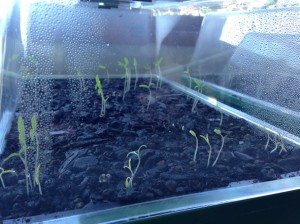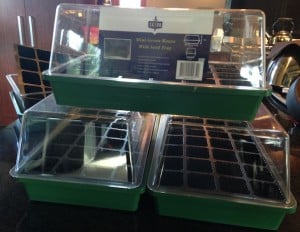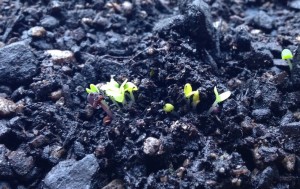We’re in the thick of Winter right now where I live.
Today we have sleet, snow flurries and a high of just 5 degrees Celsius.
With the wintery conditions making getting out in the garden a little less fun, I’m already starting to daydream about the Summer days ahead of us, with warmer temperatures, the house doors flung open, barbecues and evenings sitting in the remaining heat of the day, and being able to wear light, loose clothing instead of multiple layers just to keep warm.
And I’m starting to prepare for those Summer days on the growing and gathering front too.
It’s time to sow my Spring seeds so they’re ready when the last frost has passed and the ground is warm enough to plant out.
Waiting until Spring is just too late to start sowing. It puts me right behind in my gardening calendar and, as I’ve discovered from past experience, means a shorter growing time and a much less impressive harvest.
So, in the middle of Winter each year, when the frosts are heavy and brutal and the snow is just starting to arrive I start sowing my seed indoors to keep my gardening on schedule.
Winter Sowing for Spring
Although the basic steps are the same, sowing Spring seeds in Winter takes a little more planning and care than when you sow in Spring.
Where as in the warmer months you can pretty much drop seed into warmed soil, leave them outdoors, water them and get a reasonable success rate, Winter planting involves a little more of your usual nurturing and possibly a few extra props to improve your odds.
Mini Greenhouses
For my Winter sowing I use mini green houses that have seed flats nested in a clear box with ventilation and a water tray.
 I paid $10 each for them and they’ve been key to getting my Summer produce going for the last few years.
I paid $10 each for them and they’ve been key to getting my Summer produce going for the last few years.
Since the greenhouses get reused each year, before I use them each season I give them a good wash out and then soak them in a 1:10 solution of bleach and water to kill off any fungi or diseases that might bother my seeds.
Heating
Because it’s still so cold here and I want to provide a little extra heat to help encourage germination, I provide heating underneath my greenhouses.
There are a few ways you can warm your soil up over the colder months. There are special heating pads that you can purchase to put under your seed cells or, if your seed cells and the water are contained in units like the greenhouses above, you could use either pet electric blankets or a standard electric blanket. What ever you use I would advise you to move the trays away from the heating device before watering. Better to be safe than sorry.
Light
As we all know, light is a key factor in our seeds doing their thing. But when you’re starting your seeds off indoors it’s a bit more challenging making sure there’s enough of it.
My little greenhouses get perched right up by a big window in our dining area and sometimes, when I remember, they also get moved around the house to follow any sun coming in.
You will find that seedlings grown indoors will often lean themselves towards the window they are near, to reach more light, so you’ll need to keep turning their trays regularly if this happens.
Moisture
Your soil won’t dry out as quickly as it would in the Summer sun, but you still need to keep on top of making sure your trays are kept moist enough to encourage germination.
 Water your seeds in the morning and let them soak up that goodness during the day while it is warmer, and then they cab spend the night without cold, super wet feet.
Water your seeds in the morning and let them soak up that goodness during the day while it is warmer, and then they cab spend the night without cold, super wet feet.
Air
The mini greenhouses I use have two ventilation holes in them, which can be opened to let the air in.
Once your indoor grown seedlings have sprouted and have 2-3 leaves it’s important to provide more air to strengthen the seedlings. I tend to remove the lids at this point but you could also just prop the lid up with a 1-2 inch gap for ventilation, using wooden skewers.
Hardening
Unfortunately you can’t just transfer the seedlings you have grown indoors, straight into the garden. This is a sure way to lose those babies that you have spent time and effort growing because they’re just not used to the conditions.
To prepare my ‘youngsters’ I put the seed trays outdoors in a shaded area, starting with a few hours a day and increasing the time until the frosts have passed and I can plant the seedlings. By this time they have got used to being out in the conditions and should do just fine in the big wide world.
These are the main things you need to consider when sowing seeds indoors. It’s not difficult, it just takes a little time and attention. And space in your house!
The other important thing to consider is when you start this process.
It’s a good rule of thumb to allow 8-10 weeks from planting to the first frost so plan ahead.
Of course, if you miss that time-frame it doesn’t mean you miss the growing season, you may just find that your growing time and harvest period is slightly shorter.
Want to know more about gardening ?
Fill in your email address in the form below and you'll receive all the latest updates directly in your in-box.
Thank you for subscribing.
Something went wrong.